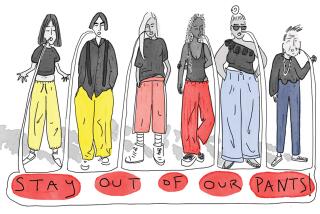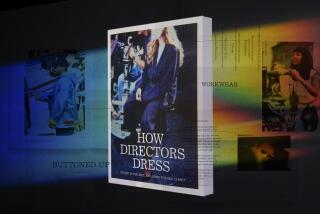Where Is White’s Bodysuit?
- Share via
WASHINGTON — You’re Anne White, and you like thinking that you’re “different” from the others, “offbeat.” You wore that clingy bodysuit at Wimbledon, and the next morning when you went to buy the newspapers you saw your picture on the front page--not the sports page, the front page--and you had to catch your breath and you thought, “Oh, my God!” You couldn’t believe the commotion your outfit had created. Why couldn’t you? You’d planned the rest of the caper. Why hadn’t you planned on that?
In March, three months before Wimbledon, you were sitting on the beach in California with a friend when it hit you: “Can you imagine a white bodysuit at Wimbledon?” You’d recently changed your training methods because your game was “terribly marginal.” You’d started practicing in tights, and you liked the way they looked and felt. You thought about “fashion and function.” It gets chilly in Wimbledon. You thought about impact, considered that Wimbledon is “a pretty prominent stage.” And you thought, “This will be something terribly outrageous to do,” which suited you just fine. After all, and you were the first to admit it, “No guts, no glory.”
So you began lining up support troops. You made sure your agent would stand behind you. Then you went to Pony, your clothing sponsor, and asked them to whip up a long-sleeved bodysuit, like the kind you’d seen on sprinters and skiers: Sew it and send it.
You went into Wimbledon ranked 93rd. Drawing Pam Shriver in the opening round, you figured to be gone quickly. It was lucky that rain delayed play for a couple of days. You were still in the tournament when Pony got the clothes to you on June 28, the day you finally played Shriver. You put on the bodysuit--two suits actually because they were “too sheer, too revealing” and you didn’t dare wear just one. Before you slipped on your warm-ups, you asked some friends for help: “Look, you guys. What do you think? You wouldn’t let me out there looking like an idiot, would you?” When they told you to “go for it,” you did.
You had no clue how it would go over: “It could be huge, or it could be a disaster.” You weren’t sure if they’d even let you play looking like that, so you brought a change of clothing, just in case. When the umpire said, “Prepare to play,” you took off the warm-ups and let everyone see the white on White motif. You didn’t hear much from the stands, and you assumed the people were “stunned” by your bodysuit.
As anxious and as self-conscious as you felt, you thought you were “going to have a heart attack and die right there on Court 2.” Looking into the stands, you saw your friends “laughing so hard, they were crying.” But when nobody said you couldn’t play, you did.
The first game you were “very nervous.” You hit three returns off the wood; you didn’t even hit the strings. You lost the first set, but won the second. If the match hadn’t been called because of darkness, you thought you had “a pretty good chance of winning.” One of the first things you did after walking past the swarm of photographers at courtside was telephone your parents to tell them not to be shocked by any “strange pictures” they might see on the news.
You looked at the strange pictures yourself the next day. The captions said you looked striking, stunning, sensational. You blushed and thought you “could’ve been a little thinner.” All in all you were tickled by what you’d done. What pleased you most was that it was your idea from the jump: “This is America. You have an idea, go do something. I had an idea. I pulled something off, you know?”
You didn’t wear the bodysuit for the completion of your match with Shriver, which you lost. The officials at Wimbledon wouldn’t allow it, and they told you so as they escorted you from the court the night before. The way they marched you off, you felt like you were “going to the principal’s office.” You said you felt “scared,” but didn’t you feel thrilled, too?
You say no one said anything resentful about your outfit, and even if they did, you “wouldn’t listen,” because you couldn’t care less what anyone else thought. But Shriver said the bodysuit was “the most bizarre, stupid-looking thing I’ve ever seen on a tennis court,” and implied your sole motivation was in seeking publicity. So did Martina Navratilova. You’d prefer not to think about that.
Since Wimbledon you’ve not only become famous, you’ve also become quite good at your job. You’re up to No. 20 on the computer, and you like to say that as a consequence of the notoriety attached to that episode, as a consequence of all the attention you’ve received, you buckled down and worked harder at tennis than ever before.
You’re Anne White and you don’t want to be thought of as “that clown in the white suit.” So you don’t wear it anymore. You only wore it once. You don’t say exactly where you keep it, just that it’s “home in California.” And even though there’s no written rule against it, you say the reason you haven’t worn it since Wimbledon is because “various people have implied it’s not proper attire.” And you care?
The Women’s Tennis Assn. has told you that you can wear it. You’re allowed. You say it has “fashion and function,” and you say you believe in it. Why don’t you wear it?
More to Read
Go beyond the scoreboard
Get the latest on L.A.'s teams in the daily Sports Report newsletter.
You may occasionally receive promotional content from the Los Angeles Times.










